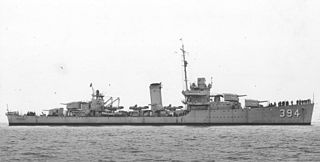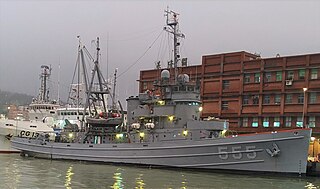
USS Wyoming was the second ship of the United States Navy to bear that name, but the first to bear it in honor of the 44th state. The first Wyoming was named for Wyoming Valley in eastern Pennsylvania.

USS Colorado (ACR-7), also referred to as "Armored Cruiser No. 7", and renamed USS Pueblo (CA-7) in 1916, was a United States Navy Pennsylvania-class armored cruiser. She was the second US Navy ship named Colorado, and the first to be named after the State of Colorado. The first, Colorado, was named for the Colorado River.

USS Hopkins (DD-6) was a Hopkins-class destroyer, which was a sub-class of the Bainbridge-class destroyer, in the United States Navy. She was the first of three Navy vessels named in honor of Commodore of the Continental Navy Esek Hopkins.

USS Guavina (SS/SSO/AGSS/AOSS-362), a Gato-class submarine, was a ship of the United States Navy named for the guavina, a fish which may reach a length of 2 feet (0.6 m) indigenous to the West Indies and the Atlantic coasts of Central America and Mexico.

The third USS Alert was an iron-hulled screw steamer gunboat in the United States Navy. The lead ship in her class, Alert was destined for a long naval career, serving from 1875 to 1922, a period of 47 years, including service as a submarine tender in World War I. Toward the end of her career she received the designation AS-4.

USS Point Defiance (LSD-31) was a Thomaston-class dock landing ship of the United States Navy. She was named for Point Defiance, a location in Pierce County, Washington, the site of a military reservation established by the U.S. Government in 1866. She was the second ship assigned that name. The construction of the first ship, Casa Grande-class dock landing ship Point Defiance (LSD-23), was canceled on 17 August 1945.

The second USS Milwaukee (C-21) was a St. Louis-class protected cruiser in the United States Navy. Entering service in 1906, Milwaukee was deployed to the Pacific Ocean. On 13 January 1917, while aiding a grounded submarine, the cruiser grounded herself. The ship was decommissioned and sold for scrap in 1919.

The first USS Iroquois was a Mohican-class sloop of war in the United States Navy during the American Civil War.

USS Moody (DD-277) was a Clemson-class destroyer in the United States Navy in commission from 1919 to 1922 and from 1923 to 1930. She was named for Justice William Henry Moody.

USS Downes (DD-375) was a Mahan-class destroyer in the United States Navy before and during World War II. She was the second ship named for John Downes, a US Navy officer.

The second USS Sampson (DD-394) was a Somers-class destroyer in the United States Navy. She was named of William Thomas Sampson a rear admiral known for his victory in the Battle of Santiago de Cuba during the Spanish–American War.

USS Ajax (AC-14/AG-15) was a collier in the United States Navy. Originally she retained her previous name of Scindia, and was renamed for the mythical Ajax in 1901. In 1921, she became a receiving ship and was redesignated AC-14. She was reclassified as a seaplane tender and given the hull designator AG-15 in 1924.

USS Anacapa (AG-49) was a Q-ship in the United States Navy. She was named for Anacapa, an island near the coast of California.
The first USS Chewink (AM-39/ASR-3) was a Lapwing-class minesweeper in the United States Navy. She was later converted to a submarine rescue ship.

Samoa is a census-designated place in Humboldt County, California. It is located 1.5 miles (2.4 km) northwest of Eureka, at an elevation of 23 feet. Samoa is located in the northern peninsula of Humboldt Bay and is the site of the Samoa Cookhouse, one of the last remaining original, lumber-camp style cookhouses. The name Samoa is used interchangeably with the peninsula it occupies. The population was 258 at the 2010 census.

USS Lipan (AT-85) was a Navajo-class fleet tug constructed for the United States Navy during World War II. Her purpose was to aid ships, usually by towing, on the high seas or in combat or post-combat areas, plus "other duties as assigned." She served in the Pacific Ocean during World War II and the Korean War. She was awarded two battle stars for World War II and four battle stars for the Korean War.

USS Narragansett (AT-88) was a Navajo-class fleet tug constructed for the United States Navy during World War II. Her purpose was to aid ships, usually by towing, on the high seas or in combat or post-combat areas, plus "other duties as assigned." She served in the Atlantic Ocean and, at war’s end, returned home with three battle stars to her credit.

USS Iroquois (AT-46) was a tugboat acquired by the United States Navy in anticipation of need for the Spanish–American War. She performed a variety of duties at a number of locations, both in the Pacific Ocean as well as the Atlantic Ocean. In 1925, she was finally decommissioned, and sold by the Navy a few years later.

USS Taganak (AG-45) – also known as USS Lake Shore (ID-1792) – was a commercial cargo ship acquired by the U.S. Navy during World War I as Lake Shore. She was again reacquired during World War II as Taganak. During both wars she carried a variety of cargo for the Navy, including coal, ammunition, and general cargo. She survived both wars and was returned to civilian service after each war.

The Humboldt Bay Life-Saving Station was originally built in November 1878 on the north side of the entrance to Humboldt Bay in northern California, United States near Eureka, adjacent to the site of the first Humboldt Harbor Light (1856–1892). Rebuilt in 1936 with marine railways to launch rescue surfboats, the historic facility was placed on the National Register of Historic Places on October 30, 1979. The station continues to function as an important asset of the United States Coast Guard in the Coast Guard Group/Air Station Humboldt Bay.




















